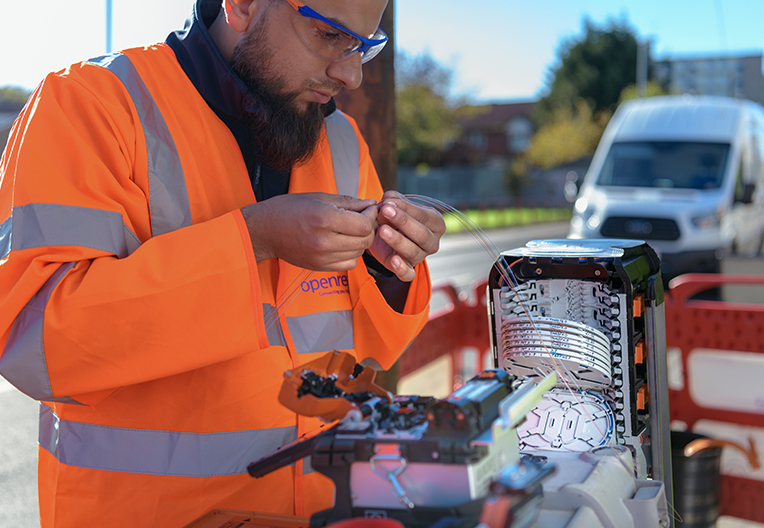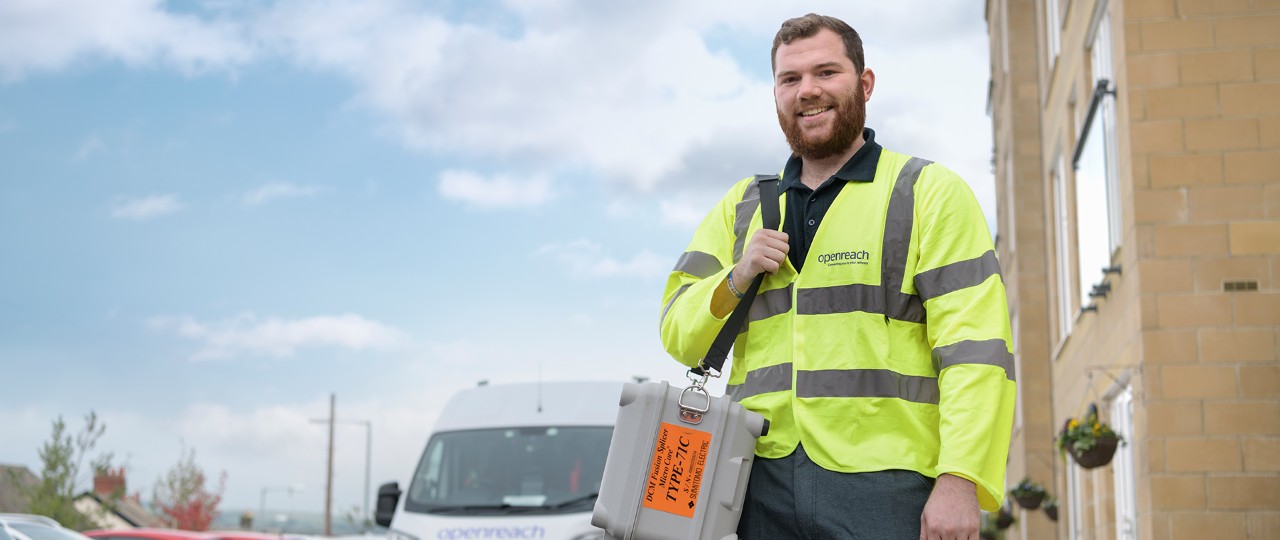Helping you find the right connection
Whether you're confused about connectivity or just need to check what's available at your address, we're here to help.
Below we explain the different ways we connect you. You can find out about our latest technology, Full Fibre, where we're cutting out the cabinet to deliver lightspeed broadband direct to your door.
Openreach engineers build and maintain the UK's communication network, and have done for many years. Our network is used by over 650 Communication Providers which you can choose from to get your broadband. Enter your postcode into our fibre checker to see what connection is available in your area.
Confused by connectivity?
There are three ways we connect you to our broadband network
Fibre to the Premise (FTTP)
Download speeds of up to 1,600 Mbps
Also known as Fibre to the Home (FTTH) or Full Fibre broadband. This is our most reliable, fastest broadband with a pure fibre optic cable straight into your home or business directly from your nearby exchange.
Fibre to the Cabinet (FTTC)
Download speeds of up to 76Mbps
Until FTTP is built to more of the UK, this is our most widely available and popular broadband type powering both our Fibre to the Cabinet Fibre broadband and GFast Fibre broadband products. FTTC provides a fibre optic cable from your nearby exchange to your local cabinet. From the cabinet to your home or business, we use traditional copper wires to power your connection.
Copper network (ADSL)
Download speeds of up to 21Mbps
Copper broadband access uses a copper phone line connected all the way from your property through your local cabinet and to your nearby exchange.
Want to know even more about our connection types?
Find out how we use fibre optic cables to connect homes and businesses to our network across the UK.
Why should I upgrade to Full Fibre broadband?
No go-slow and always on
Get better performance, impressive speeds and fewer drop-outs with fibre connected straight to your home.
It never lets you down
According to the national Infrastructure Commission, Full Fibre has five times fewer faults than copper connections.
Ready for anything
Be unstoppable on everything from phones, tablets, laptops, VR headsets – even your home’s heating controls.

What is a good download and upload speed?
Get the lowdown on broadband speed essentials in our informative blog. Uncover the differences between download and upload speeds, and learn how to keep your connection running smoothly.

Heard of Wi-Fi calling but don’t know how it works?
Learn all about Wi-Fi calling, a feature that allows you to make phone calls over a Wi-Fi network instead of using your phone provider’s network.

The UK's Full Fibre future is within reach
Research by the Centre for Economics and Business Research (Cebr) shows that Full Fibre could provide a real boost to communities across the country, reduce pollution and increase UK productivity by £59 billion by 2025.
Fibre options for different groups
-
Full Fibre broadband
/photography/people/stock-photography/girlgamer_764x528.jpg) Meet the next generation of the internet - Full Fibre broadband, built by Openreach. Check now to see if it's available for your home or business. It's ready for anything - are you?
Meet the next generation of the internet - Full Fibre broadband, built by Openreach. Check now to see if it's available for your home or business. It's ready for anything - are you? -
Fibre for business
/photography/people/business/non-watermarked/Team-working-together-thumbnail-764x528.jpg) Get faster internet speeds to your business with a fibre connection. Find out how Openreach is building the future of broadband by growing the fibre network.
Get faster internet speeds to your business with a fibre connection. Find out how Openreach is building the future of broadband by growing the fibre network. -
Full Fibre broadband for developers
/photography/people/stock-photography/new-build-construction-header-764x528.png) Want to provide Full Fibre broadband for new developments? Explore how your developments can connect to Openreach's reliable network.
Want to provide Full Fibre broadband for new developments? Explore how your developments can connect to Openreach's reliable network.




















